It’s Game (Almost) Over In the Final Squid Game Trailer

Gi-hun is down, but definitely not out in the last season of 'Squid Game' hitting Netflix in two weeks.



The Federal Trade Commission is reportedly pitching a merger condition that would forbid advertising agencies from boycotting platforms based on political content, in a move that could benefit Elon Musk's X social network and President Trump's own Truth Social platform.
As the FTC reviews a proposed merger between Omnicom Group and Interpublic Group, two large ad agencies, The New York Times reported yesterday that a "proposed consent decree would prevent the merged company from boycotting platforms because of their political content by refusing to place their clients' advertisements on them, according to two people briefed on the matter."
This is one of several moves the FTC has reportedly made to discourage ad boycotts that have riled conservatives. The FTC currently has only Republican commissioners because President Trump fired both Democrats, who allege in a lawsuit that the firings were illegal. Trump also declared sweeping executive power over the FTC and other agencies that were created to operate independently from the White House.


© Getty Images | Tom Williams
Welcome to Edition 7.48 of the Rocket Report! The shock of last week's public spat between President Donald Trump and SpaceX founder Elon Musk has worn off, and Musk expressed regret for some of his comments going after Trump on social media. Musk also backtracked from his threat to begin decommissioning the Dragon spacecraft, currently the only way for the US government to send people to the International Space Station. Nevertheless, there are many people who think Musk's attachment to Trump could end up putting the US space program at risk, and I'm not convinced that danger has passed.
As always, we welcome reader submissions. If you don't want to miss an issue, please subscribe using the box below (the form will not appear on AMP-enabled versions of the site). Each report will include information on small-, medium-, and heavy-lift rockets, as well as a quick look ahead at the next three launches on the calendar.

Quebec invests in small launch company. The government of Quebec will invest CA$10 million ($7.3 million) into a Montreal-area company that is developing a system to launch small satellites into space, The Canadian Press reports. Quebec Premier François Legault announced the investment into Reaction Dynamics at the company's facility in Longueuil, a Montreal suburb. The province's economy minister, Christine Fréchette, said the investment will allow the company to begin launching microsatellites into orbit from Canada as early as 2027.


© European Space Agency
In this video, Motley Fool contributor Jason Hall explains why he believes Starbucks (NASDAQ: SBUX) is primed to outperform the market over the next five years and beyond.
*Stock prices used were from the afternoon of June 3, 2025. The video was published on June 7, 2025.
Where to invest $1,000 right now? Our analyst team just revealed what they believe are the 10 best stocks to buy right now. Continue »
Before you buy stock in Starbucks, consider this:
The Motley Fool Stock Advisor analyst team just identified what they believe are the 10 best stocks for investors to buy now… and Starbucks wasn’t one of them. The 10 stocks that made the cut could produce monster returns in the coming years.
Consider when Netflix made this list on December 17, 2004... if you invested $1,000 at the time of our recommendation, you’d have $657,871!* Or when Nvidia made this list on April 15, 2005... if you invested $1,000 at the time of our recommendation, you’d have $875,479!*
Now, it’s worth noting Stock Advisor’s total average return is 998% — a market-crushing outperformance compared to 174% for the S&P 500. Don’t miss out on the latest top 10 list, available when you join Stock Advisor.
*Stock Advisor returns as of June 9, 2025
Jason Hall has positions in Starbucks and has the following options: short September 2025 $125 calls on Starbucks. The Motley Fool has positions in and recommends Starbucks. The Motley Fool has a disclosure policy.
The Polkadot (CRYPTO: DOT) cryptocurrency is going through some pretty exciting changes these days. The Web3 Foundation's official crypto coin is becoming a distributed supercomputer, ready to provide a wide variety of apps and services. Yet, the coin price keeps falling.
Should you pick up a few Polkadot coins while they're available for less than $5 apiece? I think that's a good idea, and here's why.
Where to invest $1,000 right now? Our analyst team just revealed what they believe are the 10 best stocks to buy right now. Continue »
First things first. Polkadot was designed to support a Web3 future. The social networks and paywalls of the Web2 world were unstoppable over the last 20 years. These days, a lot of web users are getting tired of this aging structure, looking around for new ideas. The Web3 idea is one alternative, bringing more personal freedom and giving content creators more control over their creations. In this system, gigantic hubs of advertising and social media connections are replaced by decentralized services. And Polkadot's app-building ecosystem provides a handy platform to get all the Web3 ideas done in the real world.
It's still a futuristic ideology with just a handful of early success stories. But in the long run, Web3 apps could take over your online community connections, your day-to-day financial management processes, and your favorite channels for text, video, and audio infotainment. The tools won't even run in the centrally managed cloud you know and love today, but in a new global network of blockchain-based systems. When tweaked just right, the crypto world's smart contracts can run any kind of program and perform all sorts of services. And that's what Polkadot is doing, with the help of many other cryptocurrency systems.

Image source: Getty Images.
So far, Polkadot is mostly known for its ability to interact with other blockchain networks. This coin's smart contracts can tap into Bitcoin's (CRYPTO: BTC) monetary value storage, Ethereum's (CRYPTO: ETH) sophisticated contracts, and Chainlink's (CRYPTO: LINK) real-world data reports, just to name a few.
It's also known as a complicated and cumbersome system, but that's changing in 2025. Polkadot's central blockchain will soon be replaced by a more flexible and standards-based system known as JAM (the Joint-Accumulate Machine, if you're curious). This is actually a virtual machine in the blockchain universe. It can compile and run any code for bog-standard central processors, because it's a software-driven and full-featured RISC-V processor.
For example, Polkadot co-founder Gavin Wood has made it a habit to show off old-school computer games running on a test version of JAM. His personal laptop is good enough to make that work, but the full JAM upgrade will run on hundreds of server-class computers around the world. Imagine what this on-demand supercomputer can do for the Web3 vision.
JAM is coming up, probably in the second half of 2025. It won't cause an immediate frenzy in the Polkadot community, because it takes time for people to use new tools. Then the tools must create useful apps, which in turn need to find a target audience of actual users. So it's not a magic wand that will make Polkadot's developer community's dreams come true in a heartbeat, and it won't lift Polkadot's usage-based coin price right away.
But this is a much-needed step toward a true Web3 version of the online world. In the long run, I expect Web3 alternatives to disrupt the online experience as you know it today. Web2 leaders such as Meta Platforms (NASDAQ: META), Spotify (NYSE: SPOT), and TikTok will either join the Web3 revolution or put up roadblocks instead. I can't wait to see how true innovators like Netflix (NASDAQ: NFLX) and Alphabet (NASDAQ: GOOG) (NASDAQ: GOOGL) will find their place in the Web3 era.
I could be wrong, of course. Web2 may stick around for another decade or two, as the current leaders focus on protecting the old social media world. Other cryptocurrencies can also support Web3-worthy apps, though they'll need to overcome Polkadot's built-in advantages first.
So I'm not betting the proverbial farm on Polkadot coins. I simply recommend any investor who agrees with the Web3 project's ideas to pick up a few Polkadot coins while they're cheap.
This cryptocurrency is only worth $6.6 billion today, which is a far cry from the trillion-dollar titans you see ruling today's Web2 structure. The coin price could multiply by 10 or 100 and still look small next to Meta and Alphabet. In short, Polkadot can be a big long-term winner even if it never matches the Magnificent 7 group's trillion-dollar market caps. I think that's worth a modest position in your long-term crypto portfolio.
Before you buy stock in Polkadot, consider this:
The Motley Fool Stock Advisor analyst team just identified what they believe are the 10 best stocks for investors to buy now… and Polkadot wasn’t one of them. The 10 stocks that made the cut could produce monster returns in the coming years.
Consider when Netflix made this list on December 17, 2004... if you invested $1,000 at the time of our recommendation, you’d have $657,871!* Or when Nvidia made this list on April 15, 2005... if you invested $1,000 at the time of our recommendation, you’d have $875,479!*
Now, it’s worth noting Stock Advisor’s total average return is 998% — a market-crushing outperformance compared to 174% for the S&P 500. Don’t miss out on the latest top 10 list, available when you join Stock Advisor.
*Stock Advisor returns as of June 9, 2025
Suzanne Frey, an executive at Alphabet, is a member of The Motley Fool's board of directors. Randi Zuckerberg, a former director of market development and spokeswoman for Facebook and sister to Meta Platforms CEO Mark Zuckerberg, is a member of The Motley Fool's board of directors. Anders Bylund has positions in Alphabet, Bitcoin, Chainlink, Ethereum, Netflix, and Polkadot. The Motley Fool has positions in and recommends Alphabet, Bitcoin, Chainlink, Ethereum, Meta Platforms, Netflix, and Spotify Technology. The Motley Fool has a disclosure policy.
Shares of Netflix (NASDAQ: NFLX) have likely minted many millionaires over the years. If you had invested $10,000 in its initial public offering (IPO), you would have more than $10 million today.
There probably aren't too many who invested $10,000 at its IPO and still own Netflix stock today, which climbed and crashed on many occasions. But those who invested early and held their positions are enjoying fabulous returns.
Where to invest $1,000 right now? Our analyst team just revealed what they believe are the 10 best stocks to buy right now. Continue »
Although it isn't that young growth stock anymore, it has other things going for it. Today, it's a household name with formidable assets, and it's the leading paid streaming service. Can it still set you up for life today?
Netflix has gone through several iterations on its way to becoming the leading global streaming company. It went public in 2002, five years before it became a streaming company. You would have had to have confidence in its chances as a DVD rental company to have invested at the time, so early investors either saw a great spark of innovation or were just lucky.
Today, the company services more than 300 million global viewers through its premium paid subscription channel as well as its relatively new ad-supported network. It generates increased revenue through more subscriptions, price hikes, and advertising. As more people join the ad-supported tier, it gets higher ad revenue through increased views.

Image source: Getty Images.
The company uses a top-down margin model, which means it determines what kind of margin it wants to have and spends accordingly. That could restrain how much content it produced at a particular time, but it ensures efficiency and profitability.
In the 2025 first quarter, revenue increased 12.5% year over year, and operating income increased 27%. Operating margin expanded from 28.1% to 31.7%. Management is guiding for revenue to increase 15.4% in the second quarter and for an operating margin of 33.3%, up from 27.2% last year.
Netflix shifted directions several times in the past, from its origins as a DVD company to streaming, and from a premium network to offering the ad-supported tier. There have been worries multiple times about where it might be headed, but it has always landed on its feet and continued to run.
The accelerated shift to streaming that began when the pandemic started is still winding down, and that was followed by the ad tier and a pivot to offering gaming. There hasn't been a shortage of new opportunities over the past few years, but I wouldn't be able to envision what the next stage could be.
The field is quite full today, with many of the smaller players consolidating or breaking up, figuring out where they belong in the world of streaming. Netflix has been the steady and stable leader throughout this time.
The company now produces world-class films that can compete with the best studios. It has had some limited runs of its films in theaters, but it hasn't taken that route as a significant part of its operating model. Although that could change if it makes sense, as streaming has eaten away at the box office, it doesn't seem that theaters are the next step for Netflix at this time.
Many companies have made the mistake of entering new areas that would seem complementary instead of focusing on their core competencies. It's always a balance for an innovator, and it could be something lucrative at some point in time.
Netflix stock has delivered for shareholders, and it has a premium price tag to show for it. It trades at a price-to-earnings ratio (P/E) of 57 and a price-to-sales ratio (P/S) of 13.
It was recently reported that management had plans to reach a market cap of $1 trillion by 2030. That implies the stock almost doubling, and it's not really within its control.
However, it can take action to generate higher sales and profits and boost its price. I think that's an ambitious goal, but while possible, it's not likely. Netflix is a mature company, and it would have to keep up the growth it's reporting today to double revenue over the next five years -- it would require a compound annual growth rate of 15%.
However, that assumes the same premium P/S. If that goes down, it won't be able to double its market cap even with those growth rates.
So, unless you invest a lot of money and have a long time horizon, I don't think Netflix stock will set you up for life. But it can still be a valuable part of a wealth-creating portfolio and grow over time.
Before you buy stock in Netflix, consider this:
The Motley Fool Stock Advisor analyst team just identified what they believe are the 10 best stocks for investors to buy now… and Netflix wasn’t one of them. The 10 stocks that made the cut could produce monster returns in the coming years.
Consider when Netflix made this list on December 17, 2004... if you invested $1,000 at the time of our recommendation, you’d have $657,871!* Or when Nvidia made this list on April 15, 2005... if you invested $1,000 at the time of our recommendation, you’d have $875,479!*
Now, it’s worth noting Stock Advisor’s total average return is 998% — a market-crushing outperformance compared to 174% for the S&P 500. Don’t miss out on the latest top 10 list, available when you join Stock Advisor.
*Stock Advisor returns as of June 9, 2025
Jennifer Saibil has no position in any of the stocks mentioned. The Motley Fool has positions in and recommends Netflix. The Motley Fool has a disclosure policy.
We aren't even halfway through 2025, and already, it has been a roller-coaster year in the stock market. The major indexes incurred steep sell-offs, only to snap back like nothing happened.
Some investors may be looking for ways to take their feet off the gas by investing in stocks that distribute a portion of their profits to shareholders through dividends. Dividends are a great way to generate passive income, no matter what the stock market is doing. This can be a good approach for risk-averse investors, folks looking to preserve capital, or even investors who feel they have plenty of exposure to growth stocks and are looking to balance their portfolios.
Where to invest $1,000 right now? Our analyst team just revealed what they believe are the 10 best stocks to buy right now. Learn More »
Here's why Devon Energy (NYSE: DVN), Brookfield Infrastructure (NYSE: BIP) (NYSE: BIPC), and Clorox (NYSE: CLX) stand out as three dividend stocks to buy in June.

Image source: Getty Images.
Lee Samaha (Devon Energy): Now, I know what you are thinking, and you have a point. How can an oil and gas exploration and production company be an ultra-reliable dividend stock? The answer lies in your degree of comfort with the price of oil.
To put matters into context, Devon Energy's management calculates that its "breakeven funding level" is $45 per barrel. In other words, that's the minimum price of oil the company needs to fund all its costs, operations, debt, and its fixed dividend.
Suppose you are comfortable with the implied assumption regarding the price of oil. In that case, you will be comfortable with the notion that Devon can sustain its current $0.96-per-share dividend, which translates to a dividend yield of more than 3%.
Moreover, based on the current price of oil of $63 per barrel, Devon could pay even more in dividends and/or continue buying back shares. Assuming a price of oil of $60 per barrel, management believes it will generate $2.6 billion in free cash flow (FCF) in 2025, a figure equivalent to 12.9% of its current market capitalization. In theory, that's what Devon's dividend yield could be if it used all its FCF to pay the dividend. All in all, Devon's dividend appears sustainable, barring a significant decline in oil prices.
Scott Levine (Brookfield Infrastructure): Building positions in trustworthy dividend stocks is a tried-and-true way for investors to fortify their portfolios. When reliable stocks like Brookfield Infrastructure -- along with its 5.2% forward-yielding dividend -- are available at a discount, therefore, investors would be wise to sit up and take notice. And that's exactly the opportunity that's now presented with shares of Brookfield Infrastructure trading at a discount to their historical valuation.
While investing in Brookfield Infrastructure doesn't offer a sizable growth opportunity like those artificial intelligence stocks or space stocks may offer, it does provide a conservative approach to procuring plentiful passive income. The company operates a massive portfolio of global infrastructure assets including (but not limited to) rail, data centers, and oil pipelines.
The allure of Brookfield Infrastructure for income investors is that the company generates ample funds from operations to cover its dividend payments.
BIP FFO Per Share (Annual) data by YCharts.
Over the past 15 years, the company has excelled at growing its funds from operations. From 2009 to 2024, Brookfield Infrastructure has increased its funds from operations at a 14% compound annual growth rate. While this doesn't guarantee the same results for the next 15 years, it's certainly an auspicious sign that should inspire confidence in management's ability to grow the business -- which is encouraging for those looking for passive income.
Currently, Brookfield Infrastructure stock is changing hands at 3.1 times operating cash flow, a discount to its five-year average cash-flow multiple of 4. Today's clearly a great time to load up on the stock while it's sitting in the bargain bin.
Daniel Foelber (Clorox): Clorox stock has been hit hard by a slower-than-expected turnaround, tariff risks, and cost pressures. But the maker of Clorox cleaning products, Kingsford charcoal, Burt's Bees, Hidden Valley Ranch dressing, Glad trash bags, and more could be a great high-yield dividend stock to buy for patient investors.
The great news for investors considering Clorox now is that the bulk of challenges related to its turnaround are likely over. The company's multiyear efforts to improve its internal operations -- known as its enterprise resource planning (ERP) system -- is set to begin adding cost benefits to Clorox in calendar year 2026.
Clorox's results have been improving. The company has achieved 10 consecutive quarters of gross margin expansion, showcasing better cost management even amid slower sales. Clorox expects to finish the fiscal year (ending June 30) with a 150-basis-point improvement in gross margin compared to fiscal 2024 -- even when factoring in tariff and cost pressures.
Clorox is heading in the right direction, but the stock may be selling off simply because investors have grown impatient with the company's multiyear turnaround. Another factor could be opportunity cost.
Clorox yields a hefty 3.8% and has 48 consecutive years of dividend increases -- but with three-month Treasury bills at 4.4%, some investors may prefer to go with the risk-free option.
Clorox is far from the only struggling high-yield consumer-focused brand to see its stock price around multiyear lows. Another example is Target, which has an even higher dividend yield than Clorox and has over 50 consecutive years of increasing its payout. Yet investors have grown impatient due to sluggish sales growth and weakening margins.
All told, Clorox is an excellent high-yield dividend stock for folks who want to participate in the stock market to collect passive income rather than go with non-equity products like T-bills.
Before you buy stock in Devon Energy, consider this:
The Motley Fool Stock Advisor analyst team just identified what they believe are the 10 best stocks for investors to buy now… and Devon Energy wasn’t one of them. The 10 stocks that made the cut could produce monster returns in the coming years.
Consider when Netflix made this list on December 17, 2004... if you invested $1,000 at the time of our recommendation, you’d have $657,871!* Or when Nvidia made this list on April 15, 2005... if you invested $1,000 at the time of our recommendation, you’d have $875,479!*
Now, it’s worth noting Stock Advisor’s total average return is 998% — a market-crushing outperformance compared to 174% for the S&P 500. Don’t miss out on the latest top 10 list, available when you join Stock Advisor.
*Stock Advisor returns as of June 9, 2025
Daniel Foelber has no position in any of the stocks mentioned. Lee Samaha has no position in any of the stocks mentioned. Scott Levine has no position in any of the stocks mentioned. The Motley Fool has positions in and recommends Target. The Motley Fool recommends Brookfield Infrastructure Partners. The Motley Fool has a disclosure policy.






© Build A Rocket Boy

You’ve spent hours perfecting your WordPress website. The design looks great, your content is solid, and your products or services are top-notch. But something’s wrong. Visitors aren’t staying long, and you’re not getting the results you expected.
Sound familiar? You’re not alone. Many small business owners face this exact problem. The issue often isn’t what’s on your site—it’s how people experience it.
Poor user experience is a silent business killer. When your site is slow, confusing, or hard to navigate, potential customers leave before giving you a chance. They head straight to your competitors who offer a smoother online experience.
The good news? You don’t need to be a tech expert or hire expensive developers to fix this. Simple, strategic improvements can transform how visitors interact with your WordPress site.
In this guide, I’ll share 13 practical tips that consistently improve user experience on WordPress websites. These simple changes can dramatically boost your conversions and keep visitors coming back for more.

User experience (UX) is about how easy and enjoyable it is for visitors to use your WordPress website. This applies whether they’re reading your blog, exploring your services, or making a purchase.
Think about what happens when customers walk into a well-organized store. 🛒
If everything’s easy to find and the checkout is quick, people are more likely to stay longer, browse, and buy.
The same applies to other websites: a clear navigation menu, fast load times, and a clean design keep visitors engaged.
But if your site is confusing, slow to load, or crowded with too many elements, many users will get frustrated and leave. And most won’t come back. In fact, even a one-second delay in page speed can cause conversions to drop by 7%.
That’s why good UX isn’t optional — it’s essential. The right design choices make your site easier to use and help guide visitors toward taking action, whether that’s subscribing to your email newsletter or making a purchase.
And the best part? Many of these improvements are easy to set up, even if you’re not a developer. I’ll walk you through the most effective tips in the sections below.
Here’s a quick overview of all the tips I’ll cover in this guide:
Ready? Let’s get started.
Before you can improve your WordPress site’s user experience, you need to know who you’re designing for. A great way to start is by creating simple user personas, which are fictional profiles that represent your typical visitors.
For example, if you’re running a WordPress blog targeting busy parents, one of your personas could be a working mom. She’s looking for time-saving tips, easy-to-follow guides, and parenting hacks to manage her busy life. Let’s call her ‘Sarah
Having user personas in mind helps you tailor your website’s features and content to better serve your audience. To create one, I recommend trying the free HubSpot Make My Persona tool.

Once you understand who your users are, it becomes easier to make design and content choices that actually help them.
It’s even more important to get direct feedback from your visitors if your site is already up and running. In my experience, even a simple feedback survey can uncover valuable insights about your site’s navigation, design, or content.
You can gather instant feedback using tools like UserFeedback. UserFeedback is the best choice if you want to conduct surveys among first-time site visitors. For example, you can create a feedback form asking your first-time visitors what’s working (or what isn’t) on your site.

You might also ask user experience feedback questions like, “Was this page helpful?” or “What information were you hoping to find?” This way, you collect direct, actionable feedback.
If you want to create surveys and polls to gather feedback from existing customers, then use a tool like WPForms. For instance, you could run a quick poll asking which new website features your users would like to see next.
The more you learn about your audience, the better your UX decisions will be — and the more likely your visitors will be to stick around, explore, and take action.
For more details, we have a full guide on how to choose a target audience.
📝 Insider Tips: At WPBeginner, we use WPForms to create and manage our annual reader survey. Its extensive library of 2,000+ templates, AI tools, and drag-and-drop builder make it incredibly easy to use. You can learn more about its features in our complete WPForms review.
Meanwhile, UserFeedback has helped us set up interactive surveys and understand the needs of our web design customers. It has 20+ questionnaire templates and different question types. See our extensive UserFeedback review for insights into what it can do.
A UX audit is basically a deep dive into your website from a visitor’s point of view. It helps you spot anything that might be confusing, so you can fix it as soon as possible.
One of the first things you’ll want to do is test your site for usability issues. This means checking how easily someone can navigate your site, find what they need, or complete an action.
Even minor issues, like a misplaced or hidden button, can negatively impact the user experience.
I always recommend walking through important steps on your site, like submitting a contact form or making a purchase, just like a first-time visitor would.

Take note of any steps that feel confusing, slow, or frustrating — these are your pain points and bottlenecks to address.
It’s also a good idea to track the time it takes to go from finding a feature to completing the desired action. This way, you know exactly how much time a user typically takes to convert or complete a specific action.
For a full walkthrough, be sure to check out our expert tips for how to do a UX audit in WordPress.
User experience isn’t just about design — it’s also about understanding how people actually use your site. By looking at data, you can make smart decisions to improve your website’s usability and get better results.
A great way to see how visitors interact with your pages is by using heatmaps and session recordings. Tools like UserFeedback and Microsoft Clarity can be very helpful here.
Heatmaps show you a visual map of where users click, move their mouse, and how far they scroll on your pages. Session recordings let you watch replays of actual user visits.
This is super useful for spotting areas where people might be getting confused, what they’re paying attention to, or what parts of your layout they might be ignoring.

For example, you might see that users are trying to click on something that isn’t a link, or that they’re not scrolling down to see an important call to action. This kind of direct insight helps you make specific changes to improve your design and guide users better.
This is especially helpful for improving navigation paths or identifying parts of your layout that are being ignored. For more information on this topic, read our guide on how to set up heatmaps in WordPress.
While heatmaps show you what’s happening on individual pages, you’ll also want to understand bigger trends across your entire website. This is where website analytics tools like Google Analytics can help.
Google Analytics is powerful, but it can be a bit technical for beginners, especially with newer versions like GA4. That’s why I often recommend using a plugin like MonsterInsights.
MonsterInsights makes it easy to see your Google Analytics data right in your WordPress dashboard. It simplifies the complex reports and helps you focus on information that can improve your site’s performance.
Our team uses it every day to continuously improve user experience, and it’s been very helpful. For more insights into its features, see our full MonsterInsights review.
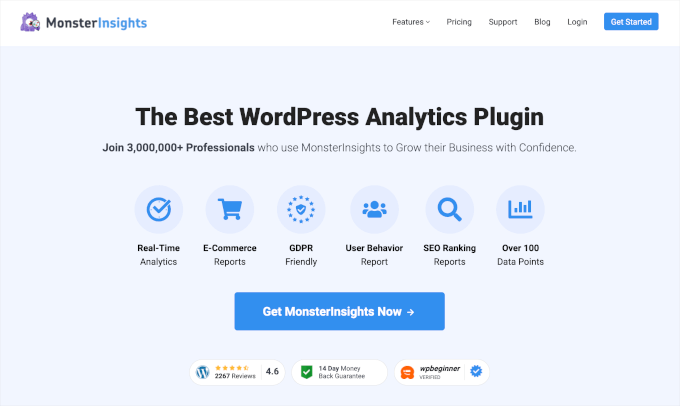
With MonsterInsights, you can follow important trends like:
These insights, which are accessible on the MonsterInsights Reports page, help you spot what’s working and what needs improvement for a better user experience.

For more information, see our guide on WordPress conversion tracking.
With more and more people browsing the web on their smartphones, making your website mobile-friendly is essential.
A site that’s hard to use on a small screen can frustrate visitors and cause them to leave. Plus, Google often prioritizes mobile-friendly sites in search results, so it’s important for your SEO, too.
A good starting point is to use a responsive WordPress theme, as these automatically adjust your site’s layout for different screen sizes.
I also recommend paying attention to your buttons and other clickable elements.
On mobile, these need to be large enough for users to tap easily with their fingers, without accidentally hitting something else nearby. This helps prevent frustration and makes your site much easier to navigate on the go.
Next, think about how your text appears on smaller screens. It’s important that your content is readable without users needing to pinch and zoom.
You can do this by choosing clear, legible fonts and ensuring the font size is large enough to read. Good contrast between your text and its background also boosts readability on mobile devices.
Another important feature is your site’s navigation. A menu that works well on a desktop might be too hard to use on mobile devices.
For instance, long or complex menus can overwhelm users on a small screen. It’s often better to use a collapsed menu, sometimes called a “hamburger” menu (an icon with three horizontal lines), or a simplified menu showing only the most essential links for mobile visitors.

Finally, make sure any forms on your site are easy to fill out on a mobile device. This can be a common pain point for users, so it’s a good idea to keep your forms as short as possible.
Using a single-column layout, making form fields large enough to tap into easily, and ensuring labels are clear will make a big difference. This makes it much simpler for users to complete sign-ups, contact forms, or checkouts on their phones.
Testing your site on different mobile devices is always a good idea to catch any usability issues.
The good news is that you can preview the mobile layout of your site from your WordPress content editor.
Some page and theme builders even let you customize the mobile version of your site from the editor.
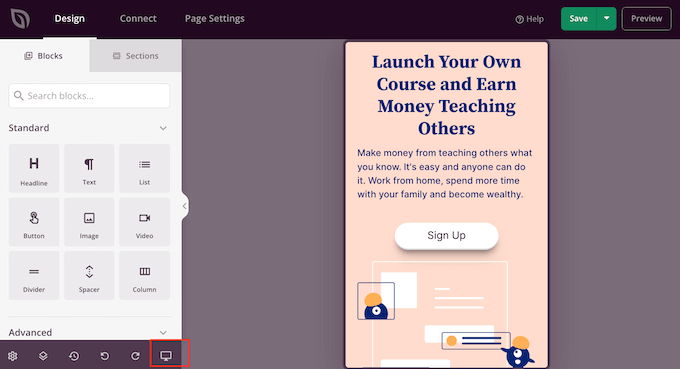
For more detailed steps, you can check out our guide on how to make your WordPress site mobile-friendly.
Did you know that websites are considered “places of public accommodation”? That’s why the Americans with Disabilities Act (ADA) allows individuals to file complaints if a website fails to meet accessibility standards.
This is a good reason to make sure your site is inclusive for all users, including people with visual, hearing, or motor impairments.
But making your website accessible doesn’t just help people with disabilities. It also improves the user experience for everyone.
One easy accessibility adjustment you can make is adding alt text and titles to your images.
Alt text is a short description of an image that screen readers read aloud. It can help visually impaired users while also giving search engines more context about your visual content for better image SEO.
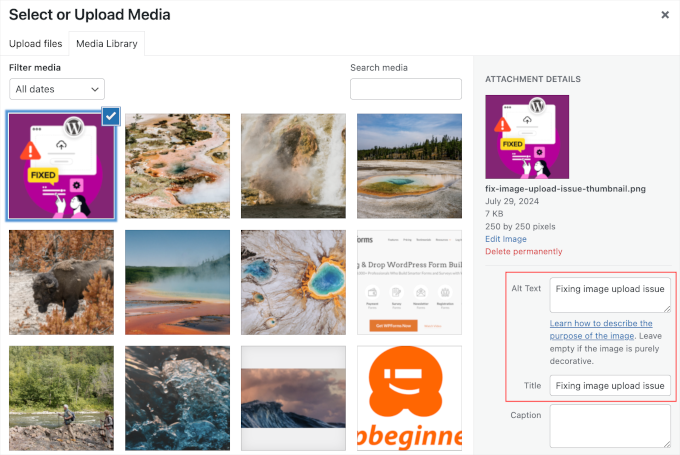
On the other hand, image titles can appear when users hover over an image, providing additional context. You can add these directly through your WordPress media library.
When it comes to fonts, you’ll want to pick options that are easy to read for everyone. This often means choosing clear, simple font styles.
For example, sans-serif fonts are generally recommended for web content due to their clean appearance.
But simply choosing a good font isn’t enough. You also need to make sure there’s enough contrast between the text and the background color. If the contrast is too low, it can be very difficult for people to read your content.

You can check your color combinations using free online tools like the WebAIM Contrast Checker.
Even with the right font and good contrast, some users may still struggle to read the text if it’s too small. One simple way to make your site more accessible is to make sure that your site design allows visitors to resize the text, which many modern web browsers support.
You can also use a WordPress accessibility plugin to add other helpful features. For example, a plugin like WP Accessibility can add “skip links,” which allow users with screen readers to jump directly to the main content, bypassing menus and headers.
All that said, true ADA compliance goes beyond just these basic steps. It involves adhering to the Web Content Accessibility Guidelines (WCAG), which provide a comprehensive framework for making web content accessible to people with disabilities.
For more in-depth insights, check out our guide on how to improve accessibility on your WordPress site.
Confusing navigation is one of the fastest ways to lose visitors. But the good news is that you can avoid this with an intuitive navigation menu. You’ll want it to be clear, simple, and easy to follow.
To improve navigation, it helps to walk through a few simple steps.
You can start by creating a logical menu structure. Stick to familiar terms like “Home,” “About,” “Blog,” “Shop,” and “Contact” so users immediately know where to go.
For example, if you’re running a business website where you sell software, your navigation should make it easy for visitors to learn about your products. In this case, key links might include “Features,” “Solutions,” “Pricing,” and “Resources.”
Plus, you may want to group similar content under dropdowns to avoid cluttering the top menu with too many items. Just make sure the dropdowns are easy to use on mobile devices.
A mega menu can be particularly helpful for larger sites. This basically consists of multiple dropdown menus to help organize large amounts of content, products, or information.

For more information, see our guide on how to add a navigation menu in WordPress.
It’s also a good idea to add breadcrumbs, which are small links that show users where they are on your site (like Home > Blog > Article Name).
Breadcrumbs make it easy for visitors to backtrack and are especially helpful for blogs and online stores with lots of content.
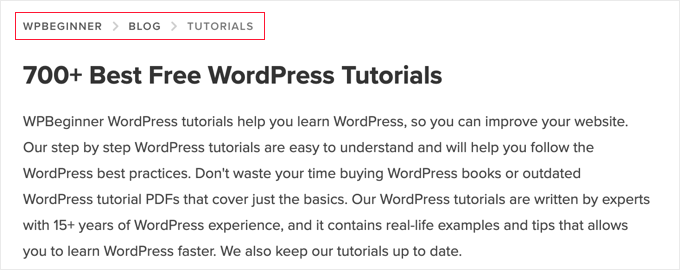
Finally, if you want to provide your visitors with the best possible navigation experience, I suggest optimizing your WordPress search.
You’ll want to make sure the search bar is easy to tap and works well on mobile devices.
The default search function isn’t always the most accurate or helpful. So, upgrading it can make a big difference, especially if you have a content-heavy site where users need to quickly find posts, products, or resources.
To do this, I recommend starting by reviewing your site’s search stats. This can show you what visitors are looking for, what they can’t easily find, and whether your current search function is meeting their needs.
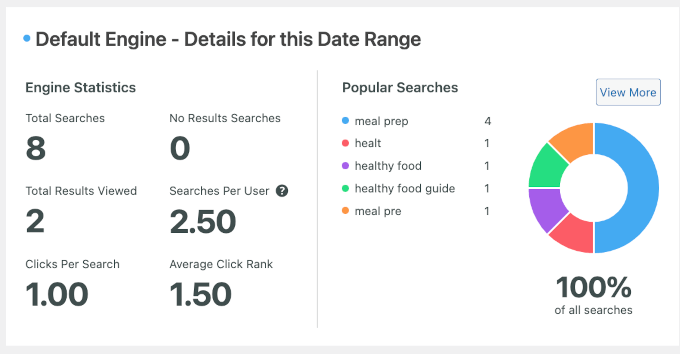
From there, you can improve your WordPress search to deliver faster, more accurate results. Learn more about it in our guide on how to improve WordPress search.
A cluttered website can overwhelm your visitors and make it hard for them to focus. It can be tempting to overdo your design with fancy features, loud colors, and animations, but it’s not always the best option.
On the other hand, clean design helps guide people’s attention to what really matters — whether that’s your content, products, or call-to-action.
That’s why I strongly recommend using clean, minimalist design principles.
For starters, it’s usually best to stick to a consistent color scheme and limit your font choices to two or three. This keeps things looking polished and makes your content easier to read.
Instead of focusing on the exact fonts or colors used on other sites, aim for consistency and readability across your own pages.
Using plenty of white space also prevents your layout from feeling crowded or cluttered. It not only looks modern but also makes your site feel more organized and professional.

I also recommend keeping each page focused by limiting the number of elements, like popups, banners, and widgets, unless they serve a clear purpose.
Too many distractions can make it hard for visitors to choose what to do next, which often leads to confusion or even higher bounce rates.
In contrast, a clean and minimalist design improves the user experience. This can also increase conversions, generate more leads, and boost engagement.
One of the easiest ways to ensure a good balance of color, fonts, and white space is by using a well-designed theme.
For tips on picking the right theme, check out our guide on selecting the perfect theme for WordPress.
If you already know you want something minimalist and easy to set up, you can take a look at our list of the best simple WordPress themes for a professional, clutter-free design.
Alternatively, you can use a page builder like SeedProd to create custom layouts that give you more control over design elements.
SeedProd lets you drag and drop elements to build landing pages, sales pages, coming soon pages, and even entire WordPress themes — no coding needed.

It’s a flexible option for beginners and non-technical users who want a completely custom look without starting from zero.
To get started building your custom pages, see our expert checklist of key design elements for an effective WordPress website.
ℹ️ Insider Tip: Want a professionally designed WordPress site without all the heavy lifting? Our WordPress Website Design Service starts at just $599 — perfect for bringing your vision to life, hassle-free.
When you show your content in an organized and user-friendly way, you’re more likely to get your message across and make it easier for visitors to understand.
To organize your content better, I recommend starting by using clear headings. They are like signposts that guide visitors along your page and help them find what they’re looking for.
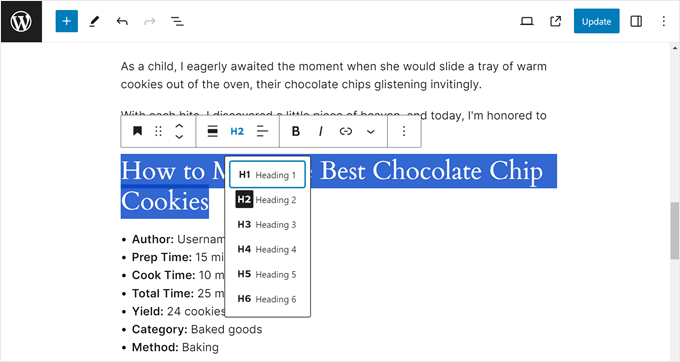
You can also use these headings to create a table of contents, like we do on the WPBeginner blog. That way, readers can quickly jump to the parts of a post or page that interest them most.
Many of our posts also start with a brief overview and then break into actionable steps using bullet points. Here’s why that helps with content organization:
Visuals can make a big difference, too. Adding images, videos, or infographics can help illustrate your points and simplify complex ideas.
In our A/B test tutorial, for example, we included a screenshot of our test results. This visual comparison helped readers quickly see which version won and why it was more effective, making the concept of A/B testing more concrete and actionable. (You’ll learn more about A/B testing in Tip #10!)
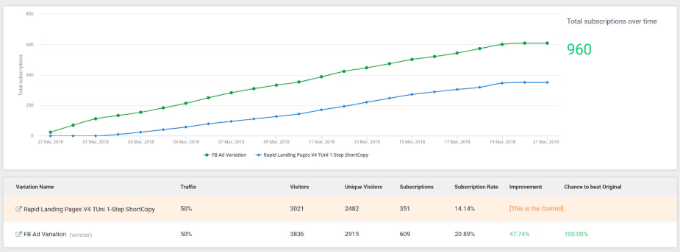
Additionally, a quick explainer GIF can help keep visitors engaged and make your content more memorable.
Want to boost interaction? I also recommend including interactive polls, sliders, or fun quizzes using WordPress plugins. These small touches can make your content feel more dynamic and invite visitors to actively participate.
Looking for more details on how you can improve the way you present content? Check out our guide on how to write a great blog post and structure it.
How quickly your website loads plays a big role in user experience. A delay of just one second can cause people to lose interest and leave your site.
That’s why improving your WordPress website’s speed and performance should be a top priority.
To start, you’ll want to use a caching plugin. Caching stores a ready-to-go copy of your site, so it loads much faster for repeat visitors.
Plugins like WP Rocket or WP Super Cache make this super easy to set up in just a few clicks. I use WP Rocket on a lot of different websites, and I’ve found that it drastically improves website loading speeds.
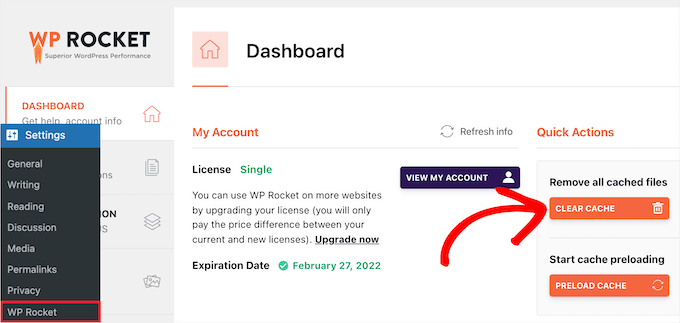
Most caching plugins also let you fine-tune your setup for even better results. For example, enabling mobile caching helps your site load faster on smartphones and tablets.
If your site includes logged-in users — like customers on a WooCommerce store or members of a private membership site — turning on user caching helps pages load faster for them, too.
Finally, enabling lazy loading delays loading images until they appear in the visitor’s viewport. This keeps your initial page load light and fast, especially on media-heavy pages.
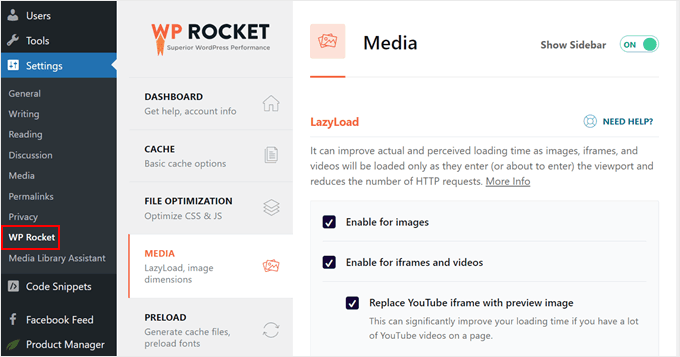
Even a few of these settings can noticeably improve your load time and reduce bounce rates, helping users stay longer and engage more with your content.
If you’d like help configuring these features, check out our full guide on how to properly install and set up WP Rocket in WordPress.
Another way to boost your speed is by adding a CDN (Content Delivery Network).
A CDN stores copies of your site’s files on servers around the world, which means users load your site from the server closest to them. This can dramatically cut down load times, especially if you have visitors from different parts of the globe.
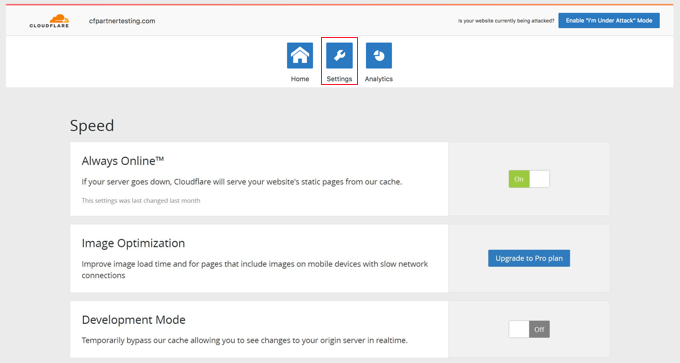
If you’re not sure where to start, we have a handy guide on how to set up Cloudflare’s free CDN in WordPress.
It’s also important to compress your images. Large image files are one of the biggest reasons sites slow down.
You can shrink your images without losing quality by using tools like TinyPNG or plugins like EWWW Image Optimizer that automate the process for you.
While you’re at it, consider switching to modern image formats like WebP. These formats offer better compression compared to traditional JPEG or PNG files, so your pages load even faster without sacrificing image quality.

Finally, don’t forget to test your site’s performance regularly. Free tools like GTmetrix or Google PageSpeed Insights can analyze your site and give you specific suggestions to make it even faster.
For more information and tips on improving site speed, refer to our ultimate guide to boosting WordPress performance.
ℹ️ Insider Tip: Want expert help speeding up your WordPress site? Our Site Speed Optimization Service can take care of it for you — starting at just $699!
When it comes to improving your site’s user experience, small tweaks can lead to big results. But how do you know what actually works?
That’s where A/B testing comes in.
A/B testing is a method for comparing two versions of a webpage or element (like a button or headline) to see which one performs better.
Here’s how it works: You create two variations (A and B), show them to different groups of visitors, and track which version gets more clicks, conversions, or engagement.
With tools like Thrive Optimize, setting up an A/B test is straightforward. It can automatically measure which version performs better for goals like clicks, signups, or purchases.
You can test things like:
For example, I ran a test in Thrive Optimize where I changed the color of the call-to-action button on a landing page. After editing the variation, I split the traffic between both versions and let the test run.
The process was simple, and the data clearly showed which version performed better. It’s a great way to improve pages based on actual results — not just assumptions.
You might find that a shorter headline keeps users engaged longer, or that placing your CTA higher on the page increases conversions.
Most A/B testing tools will automatically switch to the winning version once enough data is collected, helping you continuously improve your site’s performance.
For details on how to do it, just see our guide on how to do A/B split testing in WordPress.
🧑💻 Pro Tip: I recommend starting with high-impact pages, such as your homepage, sales page, or lead capture forms, where even a small improvement can make a significant difference.
If your posts or pages include too much unnecessary content, it can make it harder for your audience to understand your message.
That’s why it’s always best to keep your content focused and intentional. Every page should have a clear goal, and every section of content should support that goal.
If you’re building a landing page, for example, the layout and copy should guide visitors toward a single action — like signing up for your newsletter or downloading a free resource.
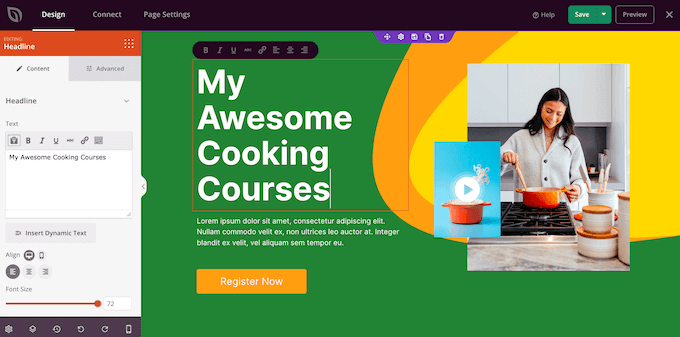
For tips on building landing pages, see our complete guide on increasing your landing page conversions.
When it comes to writing blog posts, the same rule applies. Publishing every idea that comes to mind might fill your site with content, but it won’t always serve your readers.
It’s better to focus on topics that align with your niche and help your audience solve real problems.
To take it a step further, you can group related posts around a main pillar page using a content cluster strategy. This helps improve navigation and build authority in your niche.
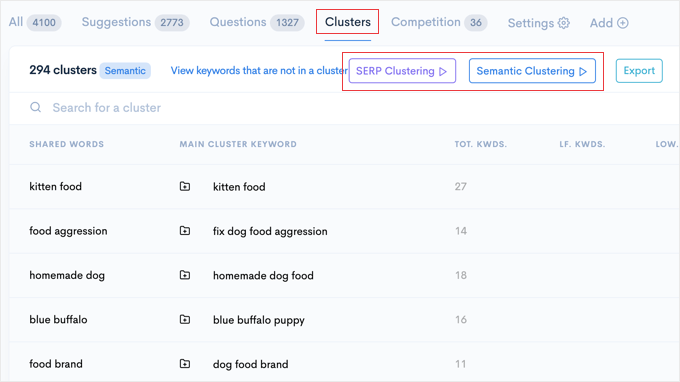
We have a full tutorial on how to build content clusters in WordPress, including how to plan them around your areas of expertise.
It also helps to do regular content audits. Over time, some posts stop performing well, either because they’re outdated or because search intent has changed.
This is called content decay. For example, a blog post titled “Top SEO Tips for 2020” might no longer rank well in search results because SEO practices have evolved.
So during your content audits, take time to review older pages and decide: should I keep, update, or delete this content?
A little cleanup goes a long way in keeping visitors engaged and helping them find exactly what they need.
When people can actively interact with your pages, they will naturally stay on your site longer.
Creating opportunities for user interaction can make all the difference. It encourages visitors to stick around, share feedback, and even return later.
A great place to start is your comments section. If it feels outdated, clunky, or inactive, people might not bother leaving a reply.
To give it an update, you can add like/dislike buttons. This way, your visitors can engage with the conversation even if they don’t want to post.
Alternatively, you might want to feature a simple user ranking system. For instance, you can pin top comments or award badges to users who consistently leave helpful remarks.
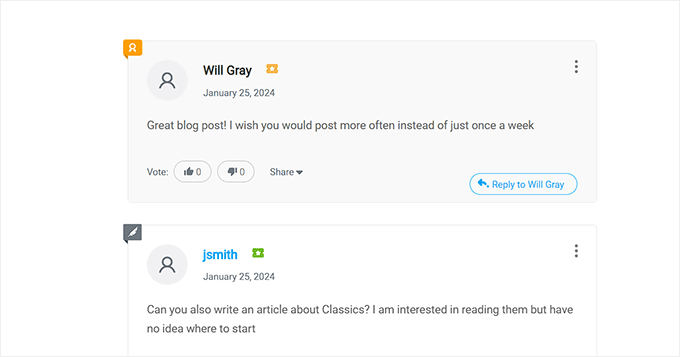
To make these improvements, you can upgrade your comment system using a plugin like Thrive Comments. It helps create a better experience that encourages more interaction and discussion.
For more options, see our pick of the best WordPress comment plugins.
You can also boost engagement by adding polls, quizzes, or quick feedback forms with a plugin like WPForms. These interactive elements encourage participation without requiring a full comment.

If you’re not sure where to start, here’s our guide on how to create an interactive poll in WordPress.
Another great strategy is gamification. This means rewarding visitors for completing certain actions — like leaving a comment, making a purchase, or finishing a quiz. You can offer points, badges, or levels that make your site more fun and encourage users to come back.
These small touches not only increase engagement, but they also boost the amount of time that users spend on your website and help build a stronger community around your content.
Want to take user interaction to the next level?
Adding live chat or real-time discussion spaces can turn passive readers into active participants, and help build trust faster.
When visitors can ask questions, get instant support, or connect with others in real time, they’re far more likely to stay, return, and engage with your content or product.
This kind of interaction boosts retention and makes your website feel more dynamic and responsive — like a real community instead of just a static page.
If you’re running an eLearning, support-based, or membership site, adding a live chat feature can make a big difference. It allows users to ask questions about course material, get help with platform features, or feel supported as part of a larger group.
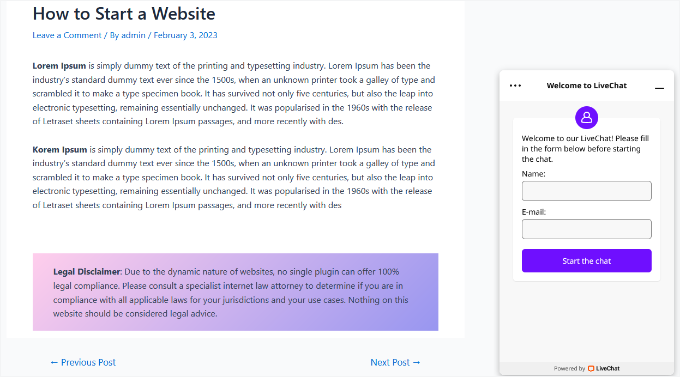
For stores or service-based websites, live chat offers instant support. It lets you answer product questions, clarify service details, or resolve issues in real time. This helps reduce cart abandonment and improves customer experience.
You can follow our tutorial on how to add free live chat in WordPress to get started.
To boost user interaction even further, I recommend creating private chat rooms or discussion boards using a tool like BuddyBoss.
It’s especially useful for membership communities or online courses, where learners benefit from peer support and group interaction.

Check out our guide on how to create chat rooms in WordPress to learn more about adding this functionality to your site.
Sometimes, even a small theme or plugin update can break your layout without you noticing. That’s where visual regression testing comes in.
Visual regression testing (VRT) helps you make sure that updates to your website don’t accidentally mess up its look or design.
The process is simple – your VRT software takes ‘screenshots’ of a page before and after you make changes to it. It analyzes the code or pixel differences of these pages to catch any visual issues early, before they hurt the user experience.

The VRTs plugin is one of the best tools for automating this process. For step-by-step instructions, you can read our guide on how to do visual regression testing in WordPress.
I hope my tips and tricks help you improve user experience in WordPress. Next, you might want to check out our guide on how to add a forum to your site and our expert picks of key design elements for an effective WordPress website.
If you liked this article, then please subscribe to our YouTube Channel for WordPress video tutorials. You can also find us on Twitter and Facebook.
The post How to Improve User Experience in WordPress (13 Practical Tips) first appeared on WPBeginner.
One weakness of Valve's Steam Deck gaming handheld and SteamOS is that, by default, they will only run Windows games from Steam that are supported by the platform's Proton compatibility layer (plus the subset of games that run natively on Linux). It's possible to install alternative game stores, and Proton's compatibility is generally impressive, but SteamOS still isn't a true drop-in replacement for Windows.
Microsoft and Asus' co-developed ROG Xbox Ally is trying to offer PC gamers a more comprehensive compatibility solution that also preserves a SteamOS-like handheld UI by putting a new Xbox-branded user interface on top of traditional Windows. And while this interface will roll out to the ROG Xbox Ally first, Microsoft told The Verge that the interface would come to other Ally handhelds next and that something "similar" would be "rolling out to other Windows handhelds starting next year."
Bringing a Steam Deck-style handheld-optimized user interface to Windows is something Microsoft has been experimenting with internally since at least 2022, when employees at an internal hackathon identified most of Windows' handheld deficiencies in a slide deck about a proposed "Windows Handheld Mode."


© Microsoft/Twitter user _h0x0d_
Julia Beverly/WireImage/Getty Images
Mark Cuban is sounding the alarm on Bluesky's declining engagement — and he's not pulling his punches.
In a series of Bluesky posts, the billionaire investor and entrepreneur criticized the platform for fostering an echo chamber that he said was driving users away and inadvertently boosting traffic back to Elon Musk's X.
"The lack of diversity of thought here is really hurting usage," Cuban wrote, linking to a Washington Post opinion piece headlined "BlueSky's decline stems from never hearing from the other side."
Once known for "great give-and-take discussions on politics and news," Cuban said Bluesky had become a monoculture where dissent was unwelcome and nuance was vanishing.
"Engagement went from great convos on many topics, to 'agree with me or you are a Nazi fascist,'" he posted.
A graph of Bluesky's unique daily posters supports his concern.
On February 28, Bluesky had more than 1 million unique users daily. Since then, engagement has plummeted, with June 7 and 8 hovering well below that peak at about 670,000 daily posters.
BlueSky's rise accelerated following the election of President Donald Trump, whom CEO Musk backed financially, and after X introduced new terms of service.
Many X users migrated to Bluesky, with some 2.5 million joining in one week in November.
Some were seeking a friendlier, more open platform with less hate speech and misinformation, and more control over what content is shown in their feeds.
A startup, BlueArk, even sprang up to help users migrate their X/Twitter histories to Bluesky, porting over millions of posts and creating the illusion of continuity on a new platform.
At the time, Cuban told Business Insider he preferred Bluesky over alternatives due to its variety of content and growing engagement.
Now, some of the earliest and most visible converts, including Cuban, are questioning whether the migration created a new community, or just repackaged the same silos.
"Why would anyone stop using Twitter if the only topic that is acceptable to you is news and politics?" he asked.
Cuban also criticized the platform's culture, saying: "The replies on here may not be as racist as Twitter, but they damn sure are hateful."
Posts about AI, business, or healthcare — traditionally strong areas for Cuban — often gain little traction or were met with outright hostility, he added.
Cuban also questioned Bluesky's business model: "How does everyone suggest BlueSky survive as a business? Or do you not care?"
Kevin Dietsch/Getty Images
No one wants to own cable networks anymore.
Would you like to buy some?
That is the pitch that Warner Bros. Discovery is making to Wall Street now that it has announced it's splitting itself into two companies: One will own Warners' movie and television studio and the HBO Max streaming service; the other — which it's calling its "global networks" unit — will own a bunch of cable TV networks including CNN, TNT, Discovery and the Food Network.
If that sounds familiar, it's for two reasons:
WBD has been contemplating this for a long time.
Last summer, it floated the same idea but didn't go forward with it. In December, it all but said it was going to do this, after all, by splitting itself up internally. Now it's doing it for real.
Comcast is doing the same thing.
Last October, Comcast said it would bundle almost all of its cable channels into a separate company (which it's calling Versant, for some reason) and hang onto its movie and TV studio and its Peacock streaming service.
Like Comcast, WBD insists that no, really, it's splitting off its cable TV networks so they can grow and thrive on their own, and you'd be lucky to buy a piece of them.
"The global networks business is a real business," WBD CEO David Zaslav said on the company's investor call Monday morning.
That is definitely true, since those cable networks continue to generate profits. It's also something you don't normally feel compelled to say when you're selling something people want to buy.
Because the big picture here is that both WBD and Comcast have concluded what investors — and people who watch things on TV — have concluded long ago: The cable TV business is a shrinking business, as more and more people cut the cord or simply never sign up for one. And the people who continue to watch cable TV are getting older and smaller in number.
The WBD split will generate all kinds of questions to ponder. Some of them are technical: How will WBD's $35 billion in debt be split up between the companies? How will the split companies approach future distribution deals with the likes of Comcast and Charter? How quickly could Comcast and WBD combine their two cable groups into one bigger cable group? Will the split help WBD's stock (it's up Monday — but note that Comcast also spiked when it announced its deal last fall, and has fallen some 20% since)?
Some questions the WBD split can generate may also matter to people who don't care about corporate finance. Such as: What does this mean for the future of CNN — the news channel that's struggling to find a lane in a loud and crowded media environment, but whose brand still has lots of potential value?
But the big takeaway is the obvious takeaway: The people who run the biggest collections of cable TV channels in the country would like someone else to own them. Because every quarter, the number of people who watch those channels and pay for those channels gets smaller.
Like I said late last year: These are garage sales. Maybe someone will want to own shrinking businesses that still throw off lots of cash (paging private equity). But the people who have them now think they'd be better off without them. Buyer beware.
Nvidia (NASDAQ: NVDA) CEO Jensen Huang thinks that data center operators will spend $1 trillion every year on chips and infrastructure by 2028 to meet growing demand for computing capacity from next-generation artificial intelligence (AI) models.
That spending will be an enormous tailwind for Nvidia, which supplies the world's most powerful data center chips for AI development. But the benefits will also flow through to the company's competitors, not to mention suppliers of other data center hardware components. There is an opportunity for investors to profit from this tech revolution, and buying an exchange-traded fund (ETF) might be the simplest way to do so.
Where to invest $1,000 right now? Our analyst team just revealed what they believe are the 10 best stocks to buy right now. Continue »
The iShares Semiconductor ETF (NASDAQ: SOXX) invests exclusively in suppliers of chips and components, and its top holdings happen to be three of the biggest names in AI: Nvidia, Broadcom (NASDAQ: AVGO), and Advanced Micro Devices (NASDAQ: AMD). The ETF has outperformed the broader stock market since its establishment in 2001, and here's how it could turn an investment of $250,000 into $1 million within the coming decade.

Image source: Getty Images.
Some ETFs hold thousands of different stocks, but the iShares Semiconductor ETF holds just 30. It aims to offer investors exposure to companies that design, manufacture, and distribute semiconductors, primarily those that stand to benefit from megatrends such as AI.
Since the ETF was established in 2001, it has helped investors successfully navigate several tech revolutions driven by the internet, enterprise software, smartphones, and cloud computing. It's now heavily geared toward AI, and its top five holdings are among the biggest names in the hardware side of the industry:
|
Stock |
iShares ETF Portfolio Weighting |
|---|---|
|
1. Broadcom |
10.07% |
|
2. Nvidia |
8.74% |
|
3. Texas Instruments |
7.49% |
|
4. Advanced Micro Devices (AMD) |
7.30% |
|
5. Qualcomm |
5.83% |
Data source: iShares. Portfolio weightings are accurate as of June 4, 2025, and are subject to change. ETF = exchange-traded fund.
Nvidia's graphics processing units (GPUs) are the most popular data center chips among AI developers. The company's latest GPU architectures, Blackwell and Blackwell Ultra, are designed for a new generation of AI models capable of 'reasoning,' which means they spend time thinking in the background to generate the most accurate responses.
Jensen Huang says some of these models consume up to 1,000 times more computing capacity than traditional one-shot large language models (LMs), hence his lofty spending forecast mentioned earlier.
Amazon, Microsoft, and Alphabet are three of Nvidia's biggest customers. They are seasoned data center operators because of their industry-leading cloud platforms, but they are now racing to build AI infrastructure to meet surging demand from developers.
But these companies are also trying to diversify their hardware portfolios by designing their own chips in collaboration with suppliers like Broadcom, which helps with the design and manufacturing processes. Broadcom is targeting a $90 billion market opportunity for its custom AI accelerator chips by 2027, with just three customers already on board and more in the pipeline. Plus, the company is a leading supplier of networking equipment, which helps to extract the most performance from AI chips.
Then there is AMD, which released a line of GPUs to compete directly with Nvidia in the data center. This year, the company will start shipping its latest chips based on its CNA (Compute DNA) 4 architecture, which was designed to rival Blackwell. AMD is also already a leader in AI chips for personal computers, which could be a major growth area in the future.
Investors will also find other leading AI chip stocks, such as Micron Technology, Taiwan Semiconductor Manufacturing, and Arm Holdings, outside the top five holdings in the iShares ETF.
The iShares Semiconductor ETF has delivered a compound annual return of 10.4% since its establishment in 2001, outperforming the average annual gain of 7.9% in the S&P 500 over the same period. But the ETF has delivered an accelerated annual return of 20.9% over the past decade, driven by the accelerating adoption of technologies like cloud computing and AI.
If the iShares ETF continues to deliver annual gains of 20.9%, it could turn a $250,000 investment into over $1.6 million in the next decade. It won't be easy, but if AI infrastructure spending grows to $1 trillion per year by 2028, as Jensen Huang expects, it certainly isn't out of the question.
However, even if the ETF averages an annual gain of 15.6% over the next 10 years, that would be enough to turn $250,000 into $1 million:
|
Starting Balance |
Compound Annual Return |
Balance in 10 Years |
|---|---|---|
|
$250,000 |
10.4% |
$672,404 |
|
$250,000 |
15.6% (midpoint) |
$1,065,413 |
|
$250,000 |
20.9% |
$1,668,026 |
Calculations by author.
Last year, Huang said data center operators could earn $5 over four years for every $1 they spend on Nvidia's AI chips and infrastructure by renting the computing capacity to AI developers. If those economics are accurate, data center operators like Amazon, Microsoft, and Alphabet are likely to continue investing heavily in new infrastructure long into the future.
Plus, every new generation of AI models typically requires even more computing capacity than the last, so it's possible that Huang's spending forecasts will prove to be conservative when we look back on this moment. In any case, the iShares ETF could be a great addition to a diversified portfolio.
Before you buy stock in iShares Trust - iShares Semiconductor ETF, consider this:
The Motley Fool Stock Advisor analyst team just identified what they believe are the 10 best stocks for investors to buy now… and iShares Trust - iShares Semiconductor ETF wasn’t one of them. The 10 stocks that made the cut could produce monster returns in the coming years.
Consider when Netflix made this list on December 17, 2004... if you invested $1,000 at the time of our recommendation, you’d have $669,517!* Or when Nvidia made this list on April 15, 2005... if you invested $1,000 at the time of our recommendation, you’d have $868,615!*
Now, it’s worth noting Stock Advisor’s total average return is 792% — a market-crushing outperformance compared to 173% for the S&P 500. Don’t miss out on the latest top 10 list, available when you join Stock Advisor.
*Stock Advisor returns as of June 2, 2025
Suzanne Frey, an executive at Alphabet, is a member of The Motley Fool's board of directors. John Mackey, former CEO of Whole Foods Market, an Amazon subsidiary, is a member of The Motley Fool's board of directors. Anthony Di Pizio has no position in any of the stocks mentioned. The Motley Fool has positions in and recommends Advanced Micro Devices, Alphabet, Amazon, Microsoft, Nvidia, Qualcomm, Taiwan Semiconductor Manufacturing, Texas Instruments, and iShares Trust-iShares Semiconductor ETF. The Motley Fool recommends Broadcom and recommends the following options: long January 2026 $395 calls on Microsoft and short January 2026 $405 calls on Microsoft. The Motley Fool has a disclosure policy.